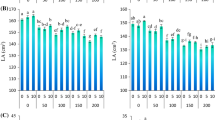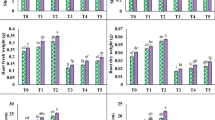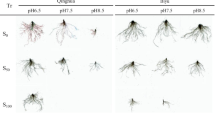Abstract
Aims
A pot experiment was conducted to determine the effects of molybdenum on antioxidative defense and osmotic-adjustment systems of Chinese cabbage under salt stress.
Methods
Molybdenum fertilizer was applied at three levels (0, 0.15, 0.3 mg kg−1). Ten days after sowing, 500 ml 136.8 mM of NaCl solution was added to half of the plants for each treatment every 10th day for three consecutive times.
Results
The results revealed that with the application of molybdenum in Chinese cabbage under salt stress the fresh weight significantly increased; activities of antioxidant enzymes such as superoxide dismutase (SOD), peroxidase (POD) and catalase (CAT) were dramatically improved; the contents of non-enzymatic antioxidants such as glutathione (GSH), carotenoid (CAR) and ascorbic acid (ASA) were significantly increased. There was also an significant increase in low molecular osmotic-adjustment products such as soluble sugar, soluble protein and proline. Moreover, molybdenum significantly increased potassium ion (K+) content and reduced sodium ion (Na+) contents, which eventually improved the K+/Na+ ratios.
Conclusions
The present study suggests that the application of molybdenum enhances the salt stress tolerance in Chinese cabbage by increasing the capacity to eliminate active oxygen and the ability of osmotic-adjustment.






Similar content being viewed by others
Abbreviations
- Mo:
-
Molybdenum
- SOD:
-
Superoxide dismutase
- POD:
-
Peroxidase
- CAT:
-
Catalase
- ASA:
-
Ascorbate
- GSH:
-
Reduced glutathione
- CAR:
-
Carotene
References
Bao SD (2002) Soil and agricultural chemistry analysis, 3rd edn. China Agricultural, Beijing
Blumwald E (2000) Sodium transport and salt tolerance in plants. Curr Opin Cell Biol 12:431–434
Bohnert HJ, Jensen RG (1996) Strategies for engineering water-stress tolerance in plants. Trends Biotechnol 14:89–97
Cheong MS, Dae-Jin Yun (2007) Salt-stress signaling. J Plant Biol 50(2):148–155
Empadinhas N, da Costa MS (2008) Osmoadptation mechanisms in prokaryotes: distribution of compantible solutes. Int Microbiol 11:151–161
Flexas J, Bota J, Galme’s J, Medrano H, Ribas-Carbo’ M (2006) Keeping a positive carbon balance under adverse conditions: responses of photosynthesis and respiration to water stress. Physiol Plantarum 127:343–352. doi:10.1111/j.1399-3054.2005.00621.x
Fukuda A, Nakamura A, Tagiri A, Tanaka H (2004) Function, intracellular Na+/H+ antiporter from rice. Plant Cell Physiol 2:146–159
Gao JF (2005) Experimental guidance for plant physiology. Higher Education Press, pp 74–76
Li HS (2000) Principles and techniques of plant physiological biochemical experiment. Higher Education Press, pp 258–260
Liang Y (1999) Effects of silicon on enzyme activity and sodium, potassium and calcium concentration in barley under saltstress. Plant Soil 209:217–224. doi:10.1023/A:1004526604913
Lichtenthaler HK (1987) Chlorophylls and carotenoids: pigments of photosynthetic biomembranes. Method Enzymol 148:350–382
Liu P, Yang YA (2000) Effects of molybdenum and boron on membrane lipid peroxidation and endogenous protective systems of soybean leaves. Acta Bot Sin 5:461–466
Liu H, Chengxiao Hu, Sun X, Tan Q, Nie Z, Xiaoming Hu (2010) Interactive effects of molybdenum and phosphorus fertilizer on photosynthetic characteristic of seedings and grain yield of Brassica napus. Plant Soil 326:345–353. doi:10.1007/s11104-009-0014-1
Lu JL (1994) Plant nutrition, 2nd edn. China Agricultural Press, Beijing, pp 18–20
Mendel RR, Hansch R (2002) Molybdoenzymes and molybdenum cofactor in plant. J Exp Bot 53:1689–1698. doi:10.1093/jxb/erf038
Mulder EG (1948) Importance of molybdenum in the nitrogen metabolism of microorganisms and higher plants. Plant Soil 1:94–119. doi:10.1007/BF02080608
Munna R (2005) Genes and salt tolerance: bring them together. New Phytol 167:645–663
Munns R, Tester M (2008) Mechanisms of salinity tolerance. Annu Rev Plant Biol 59:651–81. doi:10.1146/annurev.arplant.59.032607.092911
Nautiyal N, Chatterjee C (2004) Molybdenum stress-induced changes in growth and yield of chickpea. J Plant Nutr 1:173–181
Nie ZJ, Hu CX, Sun XC, Tan QL (2007) Effects of molybdenum on ascorbate-glutathione cycle metabolism in Chinese cabbage (Brassica campestris L.ssp.pekinensis). Plant Soil 295:13–21. doi:10.1007/s11104-007-9253-1
Nie ZJ, Hu CX, Sun XC, Tan QL (2008) Effects of molybdenum application on redox of ascorbic acid in Chinese cabbage (Brassica campestris L.ssp.pekinensis). Plant Nutr Fert Sci 14(5):976–981
Parida AK, Das AB (2005) Salt tolerance and salinity effects on plants: a review. Ecotoxicol Environ Saf 60:324–349
Pinhero RG, Rao MV, Paliyath G, Murr DP, Fletcher RA (1997) Changes in activities of antioxidant enzymes and their relationship to genetic and paclobutrazol-induced chilling tolerance of maize seedlings. Plant Physiol 114:695–704. doi:10.1104/pp. 114.2.695
Shabala S, Cuin TA (2007) Potassium transport and plant salt tolerance. Physiol Plantarum 133:651–669. doi:10.1111/j.1399-3054.2007.01008.x
Song FM, Ge XC (2001) Changes of glutathione contents in cotton seedlings infected by Fusarium oxysporum f.sp. vasinfectum and its relationship to disease resistance. J Zhejiang University (Agric & Life Sci) 27:615–618
Sun XC, Hu CX, Tan QL (2006) Effects of molybdenum on anti-oxi-dative defense system and membrane lipid peroxidation in winter wheat under low temperature stress. J Plant Physiol Mol Biol 32(2):175–782
Sun XC, Hu CX, Tan QL, Liu JS, Liu HE (2009) Effects of molybdenum on cold-responsive genes in abscisic acid (ABA)-dependent and ABA-independent pathways in winter wheat under low temperature stress. Annals Bot 104:345–356
Tandy NE, di Giulio RT, Richardson CJ (1989) Assay and electrophoresis of superoxide dismutase from red spruce (Picea rubens), loblolly pine (Pinus taeda), and Scotch pine (Pinus sylvestris). A method for biomonitoring. Plant Physiol 90:742–748
Vanrensburg L, Kruger GHJ, Kruger RH (1993) Proline accumulation as drought tolerance selection criterion: its relationship to membrane integrity and chloroplast ultra structure in Nicotiana tabacum L. J Plant Physil 141:188–194
Wan YH, Liu XD, Li ZY (1988) Determination of soil available molybdenum and plant molybdenum by polarographic catalytic wave analysis. Chin J Soil Sci 19:43–46
Wu CA, Guo DY, Qing WM, Cheng CZ (2004) The cotton GhNHX1 gene encoding a novel putative tonoplast Na+/H+ antiporter plays an important role in salt stress. Plant Cell Physiol 5:600–607
Xiao YH, He JM, Cheng Y, Zhu YM, Huang LY (2009) Effects of molybdenum on cadmium content and physiological indices of Chinese white cabbage under cadmium stress. J Anhui Agri Sci 9:3909–3910
Xiong L, Ishitani M, Lee H, Kang ZJ (2001) The arabidopsis LOS5/ABA3 locus encodes a molybdenum cofactor sulfurase and modulates cold stress-and osmotic stress-responsive gene expression. Plant Cell 13:2063–2083. doi:10.1105/tpc.13.9.2063
Xue YF, Liu ZP (2008) Antioxidant enzymes and physiological characteristics in two Jerusalem artichoke cultivars under salt stress. Russ J Plant Physl 55(6):863–858
Yaneva I, Mack G, Vunkova-Radeva R, Tischner R (1996) Changes in nitrate reductase activity and the protective effect of molybdenum during cold stress in winter wheat grown on acid soil. J Plant Physiol 149(1/2):211–216
Yu M, Cheng YJ, Xiao HD, Wang HF, Wang F, Sun XH (2005) Influences of boron and molybdenum on active oxygen species in turfgrass seashore Paspalum under low temperature. Acta Agron Sin 6:755–759
Yu M, Hu CX, Wang YH (2006) Effect of molybdenum on the catabolism of chlorophyll in winter wheat cultivas. J Triticeae Crops 2:113–116
Zakhurul I, Vernichenko IV, Obukhovskaya LV, Osipova LV (2000) Influence of nitrogen, molybdenum, and zinc on the drought resistance of spring wheat. Russ Agric Sci 4:1–5
Zhang J, Kirkham MB (1994) Drought-stress-induced changes in activities of superoxide dismutase, catalase and peroxidase in wheat species. Plant Cell Physiol 35:785–791
Zhang XL, Nie YZ, Li YH (2008) Plant cell signaling during salt stress. Lett Biotechnol 19(3):468–471
Acknowledgements
The authors acknowledge Dr Di (Soil, Plant and Ecological Sciences Division, Lincoln University, Canterbury, New Zealand) for critical reviewing and revision of the manuscript. Financial support by the Fundamental Research Funds for the Central Universities(Program No.2010PY025, 2010PY150)and Innovation Funds of Huazhong Agricultural University (52902-0900206044) are greatly acknowledged.
Author information
Authors and Affiliations
Corresponding author
Additional information
Responsible Editor: Timothy J. Flowers.
Rights and permissions
About this article
Cite this article
Zhang, M., Hu, C., Zhao, X. et al. Molybdenum improves antioxidant and osmotic-adjustment ability against salt stress in Chinese cabbage (Brassica campestris L. ssp. Pekinensis). Plant Soil 355, 375–383 (2012). https://doi.org/10.1007/s11104-011-1109-z
Received:
Accepted:
Published:
Issue Date:
DOI: https://doi.org/10.1007/s11104-011-1109-z




